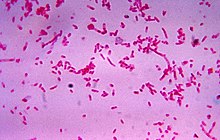| Lemierre syndrome | |
|---|---|
| Other names | Lemierre's syndrome,[1] postanginal septicemia,[1] necrobacillosis,[1] septic phlebitis of the internal jugular vein, postanginal sepsis secondary to oropharyngeal infection, Lemierre's disease |
 | |
| Fusobacterium necrophorum, the most common bacteria involved in Lemierre | |
| Specialty | ENT surgery, infectious disease[1] |
| Symptoms | Early: Fever, neck pain[1] Later: Pneumonia, pleural empyema, sepsis, brain abscess, septic emboli[1][2] |
| Complications | Septic shock, end organ failure[2] |
| Usual onset | 10 to 35 years old[2] |
| Causes | Throat infection due to Fusobacterium necrophorum[3] |
| Diagnostic method | Based on symptoms, medical imaging[1] |
| Differential diagnosis | Throat infection, mononucleosis[2] |
| Treatment | Antibiotics, anticoagulation, surgery[3][1] |
| Frequency | 1 to 6 per million people per year[1][3] |
Lemierre syndrome is infectious thrombophlebitis of the internal jugular vein.[2][4] Initial symptoms include fever, neck pain, and neck swelling.[1][2] Generally the pain and swelling is one sided and occurs at the angle of the jaw.[2] Later symptoms may include pneumonia, pleural empyema, sepsis, brain abscess, and septic emboli.[1][2] Complications may include septic shock, disseminated intravascular coagulation, and end organ failure.[2]
It most commonly occurs follow a throat infection due to the bacteria Fusobacterium necrophorum.[3] Other bacteria that may be involved include Fusobacterium nucleatum, streptococci, staphylococci, and Klebsiella pneumoniae.[1] The underlying mechanism involves spread of infection to the lateral pharyngeal space.[2] Diagnosis is generally based on symptoms and ultrasound or CT scan; as culture results take around a week.[1]
Treatment is generally with around two weeks of antibiotics by intravenous followed by up to another six weeks of antibiotics by mouth.[3] Other measures include anticoagulation and surgery to drain any abscesses.[3][1] With treatment, the risk of death is 5 to 18%.[2] Before the availability of antibiotics, the risk of death was 90% over about 2 weeks.[3][1]
Lemierre's syndrome occurs in 1 to 6 per million people per year.[1][3] Young adults males are most commonly affected.[1] In 1936, André Lemierre described 20 cases where throat infections was followed by sepsis.[5][2]
References edit
- ^ a b c d e f g h i j k l m n o p q Lee, WS; Jean, SS; Chen, FL; Hsieh, SM; Hsueh, PR (August 2020). "Lemierre's syndrome: A forgotten and re-emerging infection". Journal of microbiology, immunology, and infection = Wei mian yu gan ran za zhi. 53 (4): 513–517. doi:10.1016/j.jmii.2020.03.027. PMID 32303484.
- ^ a b c d e f g h i j k l Allen, BW; Anjum, F; Bentley, TP (January 2022). "Lemierre Syndrome". PMID 29763021.
{{cite journal}}: Cite journal requires|journal=(help) - ^ a b c d e f g h Welkoborsky, Hans J.; Jecker, Peter (1 July 2019). Ultrasonography of the Head and Neck: An Imaging Atlas. Springer. p. 222. ISBN 978-3-030-12641-4. Archived from the original on 17 October 2022. Retrieved 16 October 2022.
- ^ "Lemierre syndrome" at Dorland's Medical Dictionary
- ^ Lemierre A (1936). "On certain septicemias due to anaerobic organisms". Lancet. 1 (5874): 701–3. doi:10.1016/S0140-6736(00)57035-4.